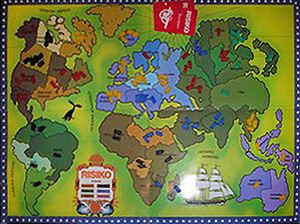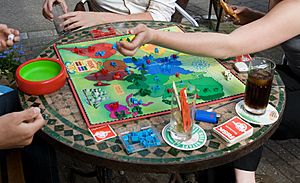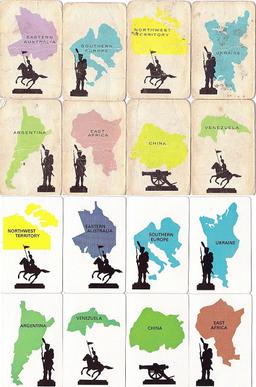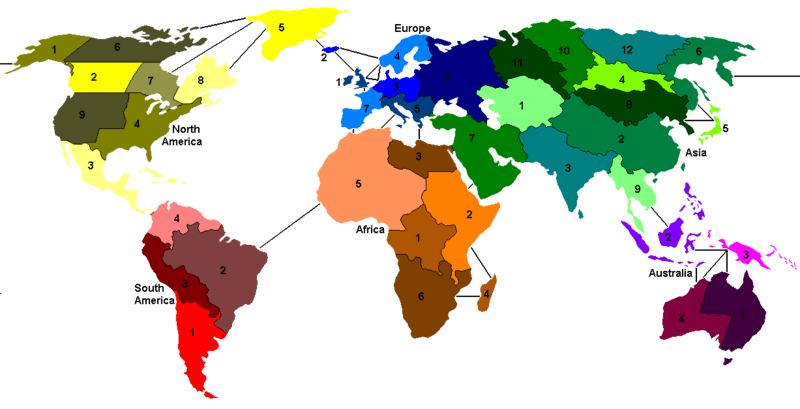Risk (game) facts for kids

Risk logo
|
|
| Publisher(s) | Hasbro Winning Moves Games USA |
|---|---|
| Years active | 1957–present |
| Genre(s) | Strategy game Board game War game |
| Players | 2–6 |
| Setup time | 5–15 minutes |
| Playing time | 1–8 hours |
| Random chance | Medium (5–6 dice, cards) |
| Skill(s) required | Strategy, tactics, negotiation |
Risk is a popular strategy board game where players try to conquer the world! It's a game of diplomacy, conflict, and conquest for two to six players. The game board shows a map of the world, divided into 42 different areas called territories. These territories are grouped into six larger areas called continents.
Players take turns controlling armies of game pieces. They try to capture territories from other players. The outcome of battles is decided by rolling dice. Players can also form and break alliances during the game. The main goal is to take over every territory on the board and defeat all other players. A game of Risk can last a long time, from a few hours to several days! Some versions of the game, especially in Europe, have "secret missions" that make the game shorter.
Risk was created in 1957 by Albert Lamorisse, a French filmmaker. It quickly became one of the most famous board games ever. It even inspired other popular games like Axis & Allies and Settlers of Catan. The rules are simple to learn, but the game can be very deep and strategic. This makes it fun for both kids and adults. Hasbro still makes Risk today, with many different versions. Some versions are based on movies or TV shows, and there are even computer games and mobile apps.
Contents
Game Pieces and Board
Every Risk game comes with several important pieces:
- Game Board: A large map of the world, split into 42 territories. These territories are grouped into six continents, each with its own color. Some territories have special routes across oceans, like between North Africa and Brazil.
- Army Pieces: Each player gets sets of different colored tokens that represent armies. Some larger tokens might stand for 5 or 10 armies to make counting easier. If you run out of your color, you can use other small items to keep track!
- Risk Cards: There's a deck of cards with 42 territory cards, two wild cards, and sometimes mission cards.
- Territory Cards: Each territory card shows one of the 42 territories on the board. They also have a picture of an infantry, cavalry, or artillery piece. You get one of these cards at the end of your turn if you conquer at least one territory.
- Reinforcements: If you collect three cards with the same symbol, or one of each symbol, or two different cards plus a wild card, you can trade them in for extra armies at the start of your turn.
- Wild Cards: These cards show all three symbols (infantry, cavalry, artillery). They can be used with any two other cards to make a set.
- Mission Cards: Some versions of Risk use these cards for "Secret Mission Risk." Each card gives you a secret goal to achieve instead of conquering the whole world.
- Dice: The game includes five or six dice. Three red dice are for the attacker, and two or three white or blue dice are for the defender.
- Golden Cavalry Piece: This piece helps keep track of how many armies you get when you trade in sets of territory cards.
World Territories
The Risk game board shows territories that look like real places on Earth. The borders are drawn to resemble actual geography. This makes the game feel more realistic and adds to the challenge. Most territories combine several countries or states. For example, "Argentina" on the board doesn't mean just the country of Argentina. Antarctica and New Zealand are not on the map.
The numbers in parentheses next to the continent names below show how many extra armies you get if you control all territories in that continent. Some game versions use different names for territories.
|
|
|
How to Play Risk
To start the game, players decide who goes first. Then, armies are given out, and players choose territories on the board. Each player places one or more armies on the territories they own.
At the start of your turn, you get new armies based on:
- How many territories you control.
- If you control entire continents (you get bonus armies!).
- If you trade in sets of territory cards.
After placing your new armies, you can choose to attack. You can attack territories next to yours that are controlled by an enemy. Territories are "adjacent" if they touch by land or by a "sea-lane" marked on the board. Battles are decided by rolling dice. The attacker and defender each lose armies based on the dice rolls.
A battle continues until:
- The attacker decides to stop.
- The attacker runs out of armies to attack with.
- The defender loses all armies in the territory.
If the defender loses all armies, the attacker takes over that territory. The attacker moves armies onto it and gets a territory card for that turn. You can only get one card per turn.
At the end of your turn, you can move armies from one of your territories to another "connected" territory you own.
You are out of the game if you lose your last territory. The player who defeated you gets all your territory cards. The last player left on the board wins the game!
Special Rules and Variations
- Two-Player Games: In a two-player game, territories are split between the two players and a neutral army. The neutral army only defends when attacked; it never attacks or moves.
- Capital Risk: In this version, each player has a "capital city" in one of their starting territories. The first player to capture all capital cities wins. This often makes games much shorter.
- Secret Missions: European versions often use secret mission cards. Instead of conquering the world, each player has a hidden goal to complete to win.
- House Rules: Many groups and clubs create their own "house rules" to change how the game is played.
Winning Strategies

The official Risk rulebook suggests three main strategies: 1. Control Continents: Try to take over entire continents to get bonus armies at the start of your turn. 2. Watch Borders: Pay attention to where other players are building up their armies. This might mean an attack is coming! 3. Defend Borders: Build up your own armies on your borders to protect your territories.
Controlling continents is a great way to get more armies. Many players try to take over Australia early in the game. Why? Because Australia is easy to defend since it only has one or two ways in (through Siam or Indonesia). Continents with fewer ways in are generally easier to defend. For example, South America has 2 access points, North America and Africa each have 3, Europe has 4, and Asia has 5.
It's usually smart to save your Risk cards until you can trade them in for the most armies. This is especially true early in the game when extra armies make a big difference. Another good strategy is to try and defeat a weak player who has many Risk cards. If you defeat an opponent, you get all their cards! If you end up with six or more cards, you must trade them in right away until you have fewer than five.
Turtling is a defensive strategy. A player who feels unsafe tries to make their position so strong that other players won't want to attack them. The goal is to avoid being defeated early. A "turtle" player might stay in the game for a long time, then suddenly attack a weaker player and start a chain reaction to win.
Working with Others (Alliances)
The rules of Risk don't say you can't make alliances or truces (agreements to stop fighting). So, players often make unofficial deals. For example, they might agree not to attack each other on one side of the board so they can focus their armies elsewhere. Or, they might team up to defeat a player who has become too powerful.
These agreements aren't official, so they can be broken! Making and breaking alliances is a big part of the game. It adds a lot of human interaction to a game that also involves a lot of luck (dice rolls).
Awards for Risk
- Risk was added to Games magazine's Hall of Fame in 1984.
- Risk was added to the Academy of Adventure Gaming Arts and Design Hall of Fame in 1995.
Different Versions of Risk
Besides the original game, many official versions of Risk have been released. Lately, Hasbro has made many Risk games based on popular movies and TV shows. Here are a few examples:
- Castle Risk (1986) – This version focused only on Europe. Players tried to protect their own castle. It was the first Risk game to change the standard rules.
- Risk: 2210 A.D. (2001) – A futuristic version where you could fight on the moon and in the oceans!
- Risk: the Lord of the Rings (2002) – Based on the famous fantasy books.
- Risk: Star Wars: Clone Wars Edition (2005) – Set in the Star Wars universe during the Clone Wars.
- Risk Express (2006) – A faster, dice-rolling version.
- Risk: Legacy (2011/12) – This game changes permanently as you play! You add stickers to the board and even tear up cards.
- Many other versions based on popular culture like Risk: Game of Thrones, Risk: The Walking Dead Survival Edition, Risk: Marvel Cinematic Universe, and Risk: Rick and Morty.
Risk Video Games
Many video game versions of Risk have been made over the years for different consoles and computers.
- The first video game versions came out in the late 1980s for computers like the Commodore 64 and Macintosh.
- In 1996, Hasbro Interactive released a PC version that included "Ultimate Risk," a new way to play without dice.
- Risk II (2000) for PC and Mac offered classic Risk plus new board and gameplay options.
- Risk: Factions (2010) was released for Xbox Live Arcade and PlayStation Network. It included a fun "factions" mode where you could play as Zombies, Robots, Cats, Soldiers, or Yetis!
- Newer Risk games have been released for PlayStation 4, Xbox One, and Nintendo Switch.
- You can also play Risk on your phone or tablet with official apps for iOS and Android devices. These apps often let you play against friends online or against the computer.
Risk on TV
In 2021, it was announced that a TV series based on the Risk game is being developed by Beau Willimon, who created the show House of Cards.
See also
 In Spanish: Risk para niños
In Spanish: Risk para niños





